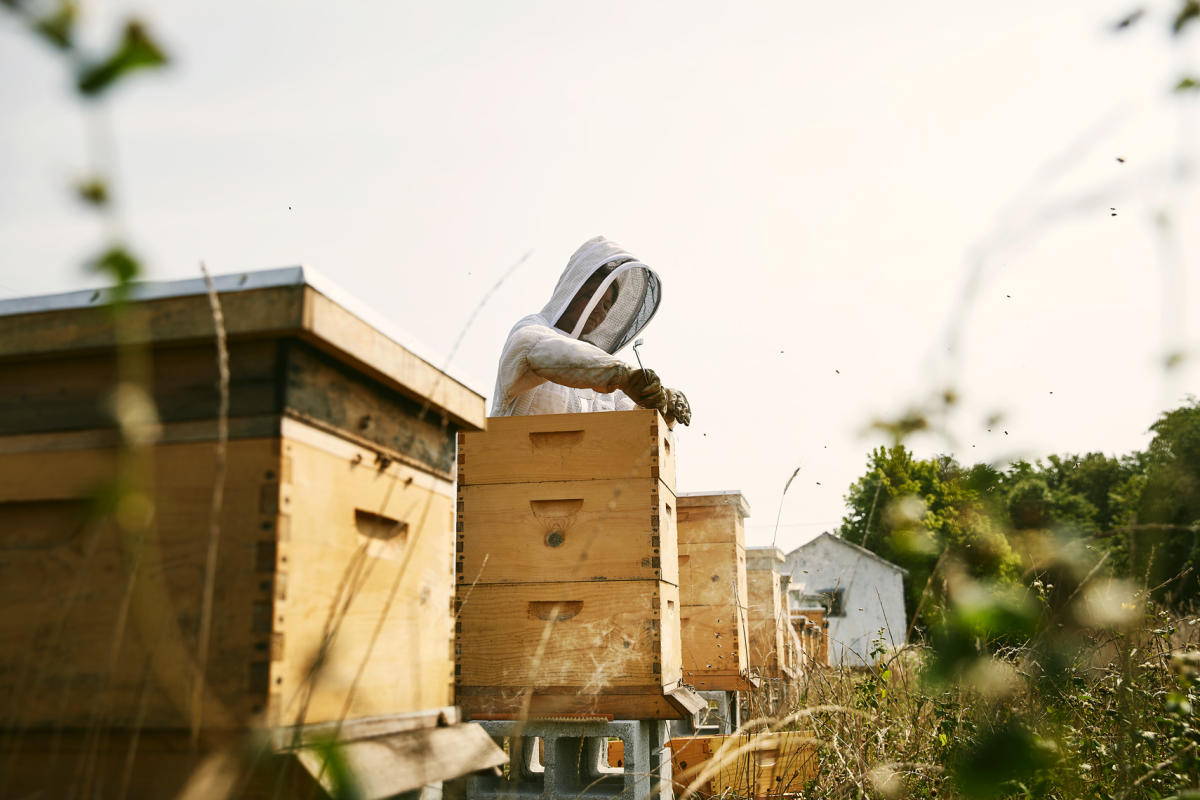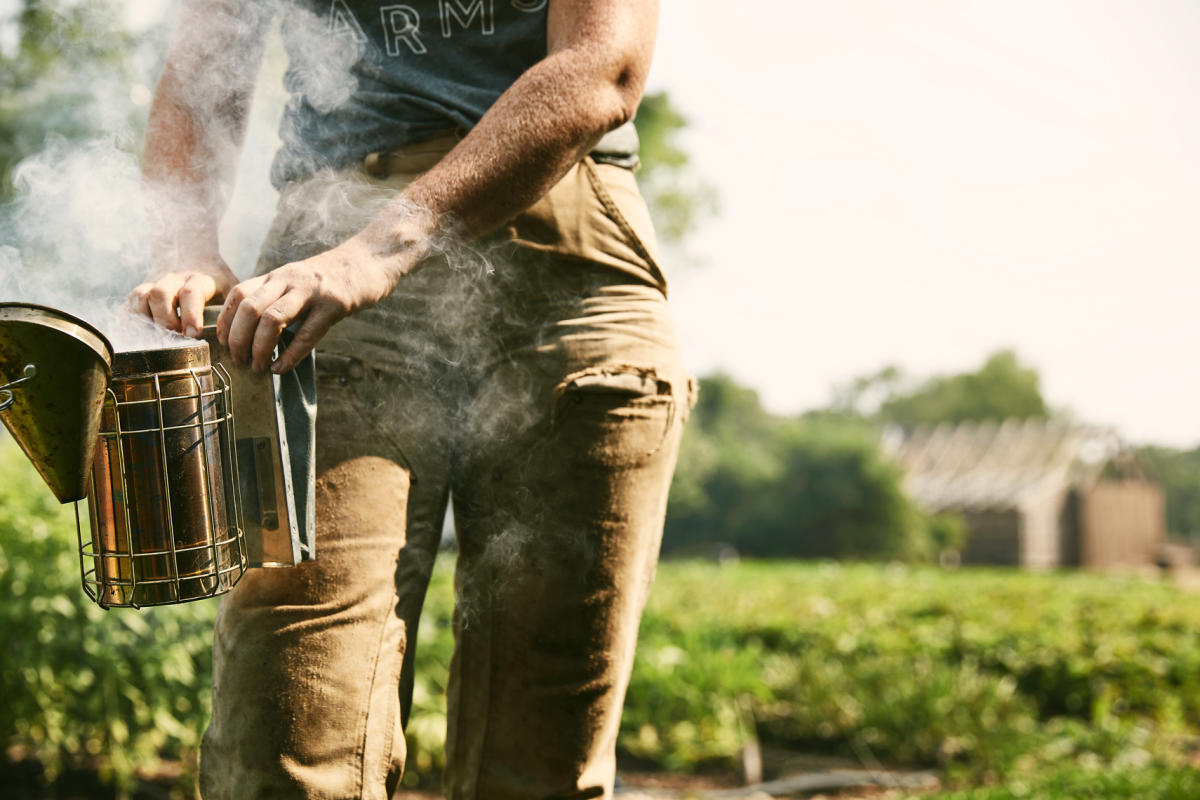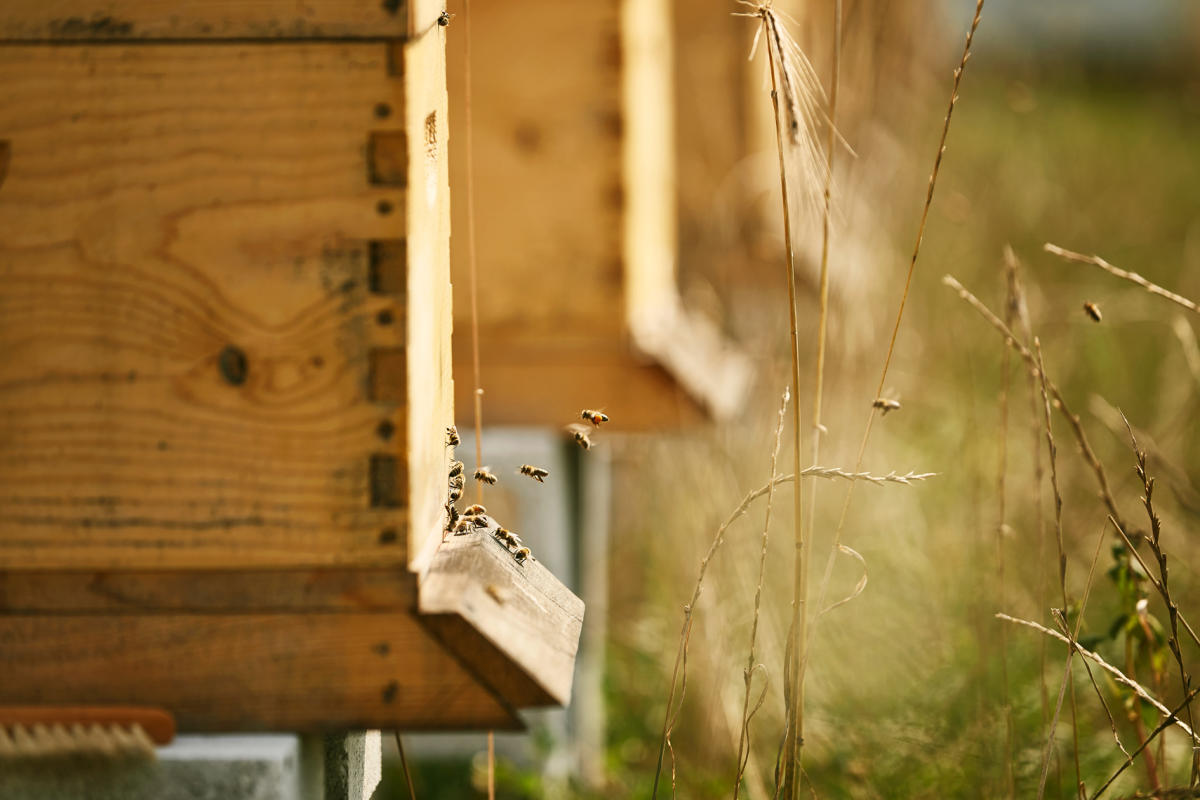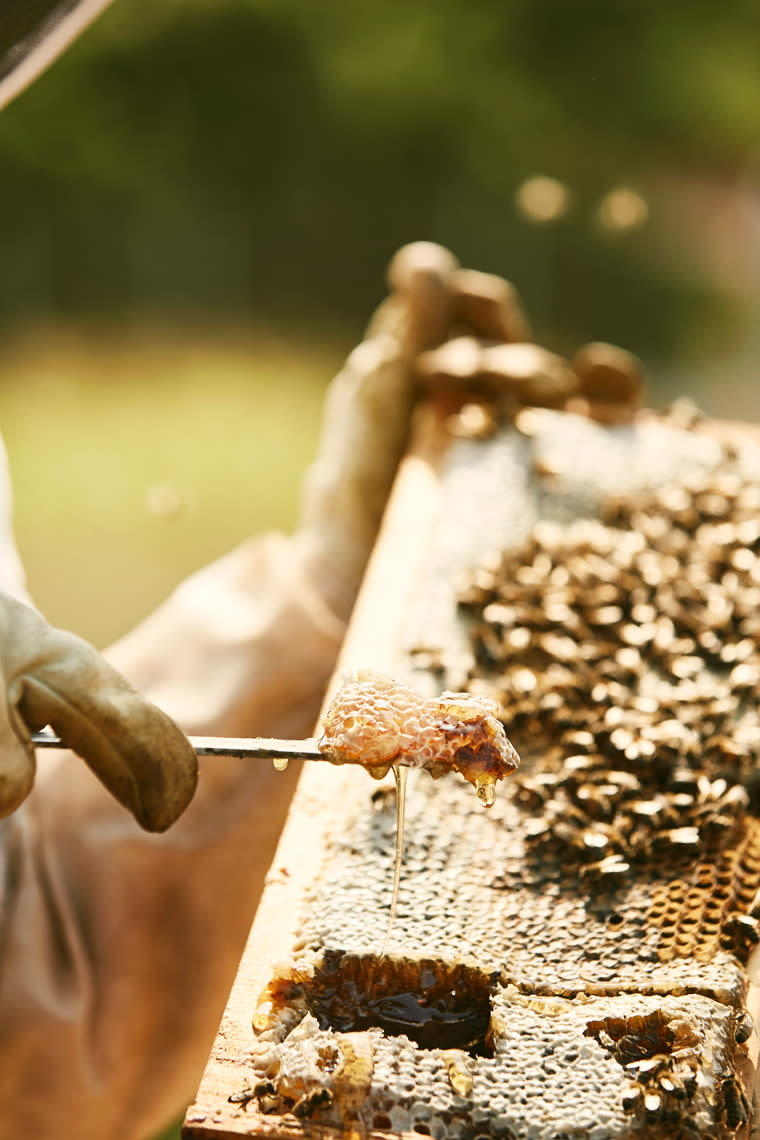I’m Madison, the social media manager behind @LoveSpringfield. This year my goal is to spend a day with interesting and often unique Springfield locals and businesses to gain insight into their lives here in the Ozarks. This morning, I was spending time with a beekeeper to learn more about the creatures and the art of beekeeping.
The world of bees was unfamiliar to me.
When I was growing up, I often saw honey bees in my neighbor’s flower garden. I remember being aghast watching a grade school classmate blow up like a balloon after getting stung by a bee. From that day forward, I kept my distance from these tiny buzzing pollinators.
When I saw the new beehive checks offered at Finley Farms in Ozark, Missouri, I decided to confront my fear. Hive checks are a new class at Finley Farms, allowing you to get up close to the hives and learn about the bees humming inside.
The Suits

Photo courtesy of Finley Farms
I arrived an hour early to survey the area and muster up my courage. Finley Farms has been open for a few years, but this was my first visit. I observed the beautiful orange brick building with a patio out to the side. Wildflowers and tomato plants covered the grounds. Farther on, I could see the small raised wooden boxes: The hives.
Beekeeper Liesel was waiting in the apiary for the class to arrive. She was already suited up in beekeeping attire. Her white jacket was covered in dirt. Seeing her kind eyes peek out from under her netted face covering was calming. It was apparent she’d done this a time or two.
Within a few minutes, a small crowd of people in light-colored clothing joined. Today there would be eight of us checking hives.
Before arriving for the class, we were instructed to wear light-colored pants and closed-toed shoes. I came prepared in white jeans and maroon tennis shoes, praying I wasn’t called out for the color of my shoes.
The white jackets were a bit of a challenge to put on. The mesh suits were covered with many different zippers and fasteners, all strategically placed to keep the bees out. After fumbling with the zippers for a bit, I managed to suit up and pull the hood over my head. My hair was bunched around my face. I shook my head a few times to get stray hairs out of my eyes. Note to self: bring a hair tie next time.
The gloves were long with white sleeves and blue rubber fingers. It took some effort to pull them on, as they were purposely tight to prevent bees from wiggling into the suit.
I noticed Liesel’s pant legs were also bound with rubber bands near her ankles. “If you’re wearing loose pants, bind your pant legs too,” she said. “They’ll find their way in somehow, believe me.”
As everyone else got suited up, I could hear the hum of the hives behind us; were they welcoming their visitors or warning us to stay away?
The Expert
 Photo courtesy of Finley Farms
Photo courtesy of Finley Farms
Liesel, a beekeeper since 2015, has more experience keeping hives in northern Michigan and Maine. She, like most beekeepers, started her beekeeping journey by taking classes. Each apprentice beekeeper kept their own beehive and maintained it over the course, examining and learning about each part. Two years ago, Leisel moved to Missouri to pursue beekeeping here at Finley Farms. Keeping bees in Missouri, however, was very different, she said.
“I’ve run into a lot of problems I never had working up north,” she explained, “For the first time ever, I’ve had to deal with hive beetles and mites.”
Just like all animals, bees have predators too. “It wasn’t just humans who had a bad year,” Liesel said. She said nearly all the bees at Finley Farms died last year due to a bad 2020, and it wasn’t just at Finley Farms. Beekeepers across the country struggled with their hives due to the drought, and many bees just died or left their hives.
Several amateur beekeepers in the group agreed. Their hives had disappeared after several months and never came back.
This year, however, is looking good. The row of hives behind us was healthy and continuing to grow.
The Hives

Photo courtesy of Finley Farms
It was time to make our way over to the hives. There were about nine hives lined up in a row, just a couple of feet from each other. The hives were in pinewood boxes held up from the ground with cinder blocks. Two red bricks on top of each lid kept them in place. At first, it appeared only a few bees were flying around, but as we got closer, it looked more like hundreds! I reminded myself to stay calm.
I asked Liesel how many bees she thought were on the farm.
“It’s hard to tell, but each hive here has to have somewhere between 10,000 to 12,000 bees in it,” she said.
I looked at the long row of hives again, realizing I was probably in the presence of over 100,000 bees. Yikes!
I rechecked my zipper to make sure it was all the way up.
One of Liesel’s main tools is a stainless-steel smoker. The smoker is about the size of a thermos with a brown squeeze bag. It contains a variety of fuels such as pine needles, wood pellets, and cardboard. The purpose was to ignite the fire inside and produce a haze that would calm the bees. Liesel grabbed the mechanism and began blowing puffs of smoke around the top and edges of the hive. The smell hung thick in the air and clung tightly to my clothes. The more she squeezed, the more smoke wafted out.
Liesel began removing the bricks from the top of the closest hive. Her movements were slow and steady so as not to disturb the hive below. As she pulled the wooden lid off the box, a cloud of bees flew out.
I stiffened a bit, wary of the thousands of bees now flying in front of our faces, but I kept calm. The bees were gentle and not aggressive.
Liesel said the only time they get aggressive is when you wear dark colors. “Bees and wasps instinctively perceive dark colors as a threat,” she said. “The only time I’ve really been stung was when I was wearing dark pants. They stung me right through my pants. I never made that mistake again.”
I had a new appreciation for my all-white attire and it was working. Thousands of bees were now flying around, and none of them were paying us any attention.
Looking back at the hive, clusters of bees were roaming among the hive frames. The frames are used as structural elements in the hive to hold the honeycomb or brood comb. The first frame Liesel pulled out was almost empty but contained a comb that looked waxy. It was on the edges of the hive to encourage structure because the hives are pretty new. As she made her way to the frames closer to the middle, these were different.
This honeycomb was more recognizable with its slightly golden color. Hundreds of bees were swarming over it. This was the brood comb, where the queen laid her eggs. Liesel held the frame up to the sun, and inside, I could see tiny white lines that almost looked like worms. They would eventually grow to become worker bees in the colony.
She started passing the frame around. We each had a turn holding it. The frame was covered in bees, all of them moving across the comb in frantic little steps. Bees had always been a blur of color before, but I could now see each black and yellow stripe lining their bodies. Their low hum had turned into a blaring buzz, making the air and everything around it vibrate. If you looked close enough, you could see which bees have recently returned to the hive. Their legs were still speckled with pollen.
The Queen

Photo courtesy of Finley Farms
The queen bee of the hive had not made her appearance yet. Leisel explained the queen was longer than all of the other bees and was slightly darker in color. Liesel had begun handing out different frames, giving us a chance to find her, but we never did. She wasn’t worried.
“If the queen was dead or they no longer liked her, the bees would tell me,” she said. In every hive, there is a circular patch of comb called the queen’s cup. If the hive needs a new queen, they will lay an egg in the cup. If the baby bee is fed enough royal jelly, food specifically made for the queen, then that bee becomes the new queen. Liesel checked the frame and saw that the cup was empty.
“She’s probably hiding, but she’s here,” she smiled.
We ventured over to a new hive, several tiers higher than all the others. This hive was thriving and nearly double the size of all the others we passed.
Because the hives are still so new, Finley Farms won’t sell honey for another year or so, but the bees are producing it. Liesel opened up the massive hive and carefully pulled out the middle frame. We each had a turn holding it. The middle frame is five times heavier than any of the others, and this one was full of beautiful honeycomb. I was holding around two pounds of honey in the single frame.
I was tempted to reach out and drag my finger across the comb but knew how easily the honey would stick like syrup. Besides, it was for the bees.
As the class ended, we walked back to shed our bee suits. I realized the panic I had about encountering bees had vanished. I had been in the midst of 100,000 bees and was never stung. Bees were not the dangerous creatures I thought they were. In fact, they were very gentle. The hives had never felt threatened by our presence.
Although I may never have the urge to start my own apiary, being among thousands of Apis mellifera that keep our crops growing and our gardens flourishing was an experience of a lifetime!
If you’re interested in attending a beehive check class at Finley Farms; visit their events page for more details.














